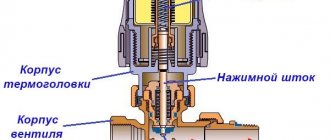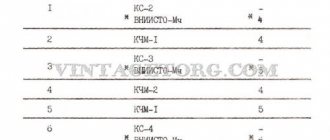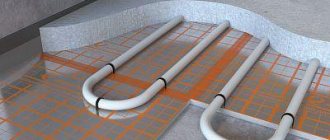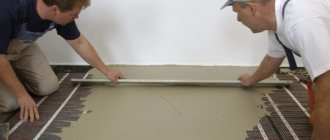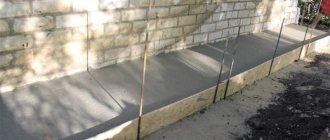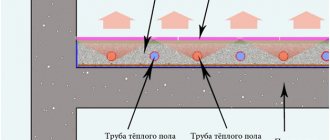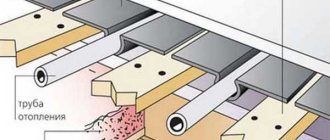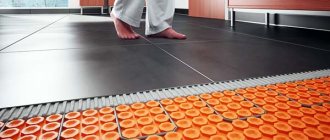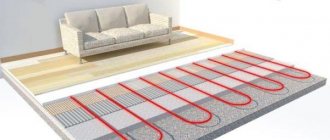Life is full of examples when something grandiose, monumental holds or works thanks to small details that non-specialists are unlikely to know about. For example, in construction, when pouring screed, a technological gap is needed. Which of the home craftsmen knew about this before they climbed onto the World Wide Web in search of appropriate instructions. That's right - units.
And why should they know - they are not professional builders. Although the “pros” often screw up: either they will forget about the problem, or they will deliberately ignore it in order to speed up the work. And those who knew previously used wooden slats or pieces of reinforcement (then removed), pieces of linoleum or bubble polyethylene from packaging to maintain the distance between the main wall and the screed. Manufacturers of building materials knew firsthand about the constantly emerging difficulties. The problem was solved simply: they began to produce a special damper tape for floor screed.
The editors of the StroyGuru portal decided to help all those who carry out repair and construction work at home with their own hands: tell what damper tape is, why it is needed, what varieties can be found on sale, how to choose the right one and attach it to the wall. Let's talk about manufacturers and prices.
What is it and why is it needed
Hardened cement-sand mortar has one unpleasant property - it expands under the influence of temperature and humidity. The screed also has it. It “breathes” both in height and width. In this case, the linear dimensions in length/width vary within 0.5 mm per 1 m2, but not more than 1.0 cm in total.
But even an expansion of 2-3 mm is enough for the screed to either collapse itself or damage the wall. A layer of material that can dampen (extinguish) the breathing of cement stone saves from the destructive consequences.
The builders forgot about the damper tape.
Definition
The word damper came into the Russian language from Germany. There “Dämpfer” - muffler, shock absorber, from the verb “dämpfen” - to muffle. Therefore, in a general sense, a damper device is understood as anything capable of preventing vibrations that occur in machines, devices, systems or structures during their operation.
Taken in a narrow sense, a damper tape (sometimes called edge or compensation tape) is a specially made strip of elastic material that can compensate for the linear expansion of concrete and other building materials under the influence of moisture and temperature.
If this definition is translated into a simple language understandable to a non-specialist, then the tape should be understood as a voluminous, plastic material that can compress when the screed expands and recover when its size decreases, while constantly maintaining some gap between the wall and the expanding cement stone.
Functions
The main task of the damper tape is to ensure free expansion of the screed. Those. A plastic strip of material several millimeters thick, fixed along the perimeter of the walls, creates a technological compensation gap that allows maintaining the integrity of the surface layer of the poured base for the finishing floor covering.
In addition to the main function, there are a number of auxiliary tasks that are no less important for apartment owners:
- creation in certain areas of a restrictive barrier for the solution, a kind of formwork;
- organization of additional hydro- and thermal protection at the joints between the floor and walls;
- strengthening sound insulation in the most vulnerable areas of the house that transmit structural noise;
- absorption of microvibration of walls due to mechanisms operating in the building, such as forced ventilation or an elevator - are not transmitted to the floor, but through it to a person;
- In some cases, leveling the walls and the base of the floor, at the joints between them, under the screed.
It is a mistake to think that the compensation layer is needed solely for the screed. The increased popularity of plasterboard walls and partitions has shown that gypsum plasterboard also expands and is destroyed without a special strip under the guide profile. This strip is called profile damper tape.
What is it for?
Since there is no mention of damper tape in SNiP, we can only talk about what this polyethylene strip is needed for as a recommendation. Therefore, the use of a compensator is desirable:
- when pouring cement-sand screed, wet and semi-dry;
- when filling expanded clay to level the floor (dry screed);
- when heating floor coverings made of tiles, porcelain stoneware, laminate, linoleum using water and cable “warm floor” systems;
- creating blind areas outside the building.
In large rooms, the compensating gap along the walls is not enough. It is placed in the middle of the screed at certain intervals using a T-shaped strip of polyethylene foam. You also need a damper tape for the self-leveling floor. Don't forget about the tape for the drywall profile.
Application of compensation edge material
Do you need a damper tape for the screed? Definitely yes. But is it necessary for a self-leveling floor? Its “work” is related to the design features of the floating floor; as for the self-leveling or leveling mass, they belong to the contact types of subfloor leveling. That is why the use of a compensator in such conditions is not at all necessary.
In addition to its main function, the expansion compensator also acts as a restraining barrier for the spreading solution.
It is also used for external work when constructing a blind area. With sharp temperature fluctuations, the soil underneath begins to swell, and cracks and crevices form on the concrete over time. Therefore, a damper tape is placed in the expansion joint at the junction of the blind area and the walls. The same applies to sedimentary seams running across the blind area. The material compacts and fills excess gaps. It absorbs all kinds of vibrations, thereby compensating for vibrations.
What is it made from?
Ideally, the damper edge tape should have the following characteristics:
- have a low thermal conductivity coefficient;
- have good plasticity, allowing volume to be restored after compression, which, however, is not important. After all, after the screed has set, the damper can be removed;
- do not be afraid of moisture, do not absorb it, so as not to create a favorable environment for the growth of mold and mildew;
- be light and easy to use.
All these qualities are fully manifested in tapes made of foamed polyethylene, which can be chemically cross-linked (PPE or HPPE) and non-cross-linked (NPE). Both materials have similar technical and operational indicators, which affects prices. They are almost equal.
On sale you can find tape made from densely woven polyester fibers, as well as from foamed synthetic rubber. The tape is sold in rolls of 10, 15, 20, 30, 50 and 100 m in length. It can be in the range of 3-10 mm in thickness, 8-15 cm in width. The widest, 150 mm, is a damper tape for warm floor.
Standard sizes of compensation tape
vidi-3vidi-1vidi-2
The price of a compensator depends on its type. The following types of products of this type are distinguished:
- Regular. This is a simple strip of polyethylene foam, which is laid along the walls of the room;
- Self-adhesive. Unlike a simple one, on its reverse side there is an adhesive strip of smaller sizes, covered with a backing. Before installation, remove it and apply the adhesive side directly to the wall. This is very convenient when pouring screed mortar, since the tightly adhered compensator does not move.
- With a skirt. A skirt is a small piece of dense oilcloth material of sufficient strength that protrudes from the polyethylene part. When it is fixed, the skirt lies on the floor, covering part of it. This seals the angle between the floor and the wall. The width of the skirt ranges from 30–100 mm.
Tapes are produced in rolls, the length of which can range from 10 to 100 m, and the width, respectively, from 50 to 150 mm. The thickness is about 0.3–1 cm, with a thickness of 5 mm considered optimal. Such a wide range of standard sizes makes it possible to accurately select a product for each specific case.
It has different geometric dimensions:
- Width. Varies from 50 to 150 mm;
- Thickness. Can be from 3 to 10 mm;
- Roll length – from 10 to 100 m.
An important point is the shape - it will directly affect the complexity of installation.
- The simplest design is a straight strip that is attached along the wall using adhesives or double-sided tape. Self-adhesive can be installed quickly enough, and it will be securely fixed.
- The best option would be to install a corner model. It has a bend that allows installation on the wall and part of the floor. This will contribute to better thermal insulation and noise absorption.
- If the height of the concrete surface is not constant, it is recommended to lay a damper tape for the screed with a tear-off top edge. Typically the pitch is 2-3 mm, which makes it possible to install the roll with minimal protrusion relative to the screed.
Any type of damper tape comes in the form of rolls. Which in turn can have different lengths. This parameter mainly depends on the width of the tape.
- Standard roll lengths range from 10 to 100 meters;
- The strip width can be in the range of 20-150 mm;
- Its thickness can range from 3 to 10 mm.
When choosing the required size, you should rely on the area of the future screed and its thickness.
The width of the tape is selected based on the following calculation: the height of the screed at the highest point is 2 cm. The tape must protrude above the concrete in order to completely eliminate even the slightest contact with the wall; The larger the pouring area, the thicker the damping tape should be. This is necessary so that voltage compensation occurs fully.
For large areas, it is better to use the T-shaped variety; When calculating the required amount of tape, you should take into account not only the length of all walls, but also do not forget to go around various protruding surfaces - columns, partitions, etc.
Is it possible to do without it?
Some experts argue that expansion tape is only needed for floating screeds. If the CPR is poured directly onto a rigid base, for example, in a garage on a concrete floor slab, then you can do without a damper tape. It is not needed for self-leveling floors with a thin layer of self-leveling mixture.
Let's try to figure out whether a damping strip is needed in the listed cases. Let's start with the screed. Let's not theorize, but refer to accumulated experience. There is no need to go far - look at what is happening (or was happening) with the screed in houses built in the 80s of the last century: CPR was poured directly onto the floor slabs without a damper tape (it began to be widely used in the late 90s). After a few years, the layer of mortar crumbled, in most cases in the heating area. Fortunately, there is linoleum on top, which is not critical for the floor covering.
The argument about thin self-leveling floors is also unclear. For thick people it is necessary, for thin people it is not. Where is the logic? After all, linear expansion in length/width does not depend on the thickness of the concrete. It is always equal to 0.1 mm per 1 m of length when the temperature increases by 1oC. Let us especially emphasize - at +1oС.
Where you really don't need a damper tape:
- frame houses. The walls there are not concrete or brick, and the screeds do not provide resistance to linear expansion;
- The thermal insulation is made with rolled materials extending onto the walls to the thickness of the CPS filling - they act as a shock absorber.
Conclusion: damper tape is always needed for hard walls. The owner of a house or apartment can refuse the compensation gap only at his own peril and risk.
As for the damper tape for the profile under plasterboard, in the bathroom when installing a false wall (box), it is required. When installing interior walls, it is advisable to lay. But nothing bad will happen if the owners refuse to use the compensator strip.
What to consider when purchasing tape
- Take into account the proposed floor structure and the budget allocated for repairs.
- Pre-calculate the required footage of the product, purchase the product with some reserve.
- Remember that damper tape is sold in rolls.
- Pay attention to the smooth appearance, absence of damage, dirt, stains, and uniform density of the roll. You should not choose a tape that is cheaper in price but has defects.
- During transportation of the purchased material, ensure that it does not suffer any mechanical damage.
- It is recommended to store the product rolled up in a room with dry air at normal room temperature.
Is it possible to replace it with something?
To save money, the damper tape can be replaced. Suitable for this:
- wooden slats;
- strip of plywood;
- trimmings of linoleum and polymer materials;
- Styrofoam;
- wooden strip wrapped in plastic film - allows you to remove the strip. Without film, wood is difficult to remove. In most cases, it remains and takes on the pressure of the screed.
There is a lot of criticism of these materials from experts. But it is baseless. After all, the damper can simply be removed and the gap closed with a plinth.
Additional Buffer Tape Features
In addition to its main purpose, which is to compensate for thermal expansion of the base of the floor, the polyethylene wall strip is assigned the following functions:
- serves as a temperature barrier between the wall and the floor;
- is a waterproofing layer between two surfaces;
- serves to dampen sound vibrations transmitted from wall to floor and vice versa (relevant in apartment buildings);
- prevents the migration of microorganisms (bacteria, mold).
Advantages and disadvantages
The damper tape has a number of significant advantages:
- durability - the service life is comparable to the service life of the screed;
- elasticity - volume and geometric dimensions are restored when the load is removed;
- good thermal insulation properties - thermal conductivity coefficient no more than 0.035 W/(m*K);
- ability to cut off structural noise;
- environmental safety - does not emit harmful substances when heated, is not an allergen;
- the material does not rot or decompose;
- low moisture absorption - picks up no more than 2% water per day;
- simple fastening;
- affordable price.
Among the disadvantages is flammability.
The best unpretentious conifers for the garden
We have created a small database of unpretentious coniferous plants that will require only minimal care. Of course, planting them in the country and forgetting them for several years is wrong. But there will be many fewer worries with such plants.
Unpretentious junipers for the garden
Of the total number of unpretentious conifers, the largest number is among junipers. Plants grow quickly and gain strength, feel normal in the sun and shade, on almost all types of soil. It is most correct to plant junipers on slopes, in rockeries.
- Chinese juniper. Chinese juniper, or Juniperus chinensis, is a truly luxurious plant with a bronze-yellow color. Ephedra is resistant to various weather conditions, as well as many diseases. It grows up to 2 m tall and spreads out to about the same distance in radius, showing dense greenery.
- Horizontal juniper Juniperus horizontalis. We present to you a type of unpretentious juniper called Andorra Compact. This is a small plant that grows to only 30-40 cm, but spreads up to 1 meter to the sides. The needles have a very interesting color - with gray, blue and bluish shades, which in winter takes on a more purple color. Juniper feels good on sandy loam, in a humid environment, and tolerates both sun and partial shading.
Juniper horizontal Wilton. This species is an original ground-blooded shrub that spreads along the ground in a dense carpet of silver-blue needles. Juniper is great for landscape design, especially for designing rocky gardens, because it is only 10-15 cm in height, but grows up to several meters in width!
Unpretentious spruces for the garden
Many of us have tried to grow or are still growing spruce today. But it is worth knowing that the most unpretentious are the following:
common spruce, or, as it can also be called, spruce Picea abies. At the moment we recommend you Barryi spruce! This is a dwarf form that grows very slowly, but shows itself to be a strong and fairly resilient plant. Approximately 8-10 years after planting, the spruce can reach a height of 2 meters. The spruce needles are dark green with a charming sheen, and the crown in the first years of life is rounded. As it matures, the spruce loses this shape.
- Picea abies Nidiformis is another beautiful and unique species of spruce that surprises and evokes positive emotions. This coniferous plant is a nest-like dwarf form, which is very popular in landscape design. We can say that the plant does not have a trunk, since all the branches and shoots grow in a spreading fan. But this does not in any way interfere with the originality of the coniferous plant. The needles are short, often light green in color, and the plant’s height is only 0.5 m. The width reaches 1 m, which allows the plant to acquire a very attractive shape.
- The common blue spruce Glauca Globosa is a semi-dwarf species that grows very slowly. Only at the age of 27-30 years will the plant reach a height of 3 m. The crown is rounded, and the needles are blue and silver-blue, very prickly.
Unpretentious pine trees in the country
Among the unpretentious pines we can list the following:
mountain pine Pinus mugo, which is also called Winter Gold. Very small, slow growing, up to only half a meter in 10 years, it is a squat and spherical plant of light yellow or even golden yellow color. Thanks to its unique color and growth, pine fits perfectly into the landscape design of a dacha;
mountain pine Ophir. This is another representative of unpretentious conifers, which is able to please with its unusual and even surprising appearance. The pine is very small and round, grows about the same as the previous species, only up to half a meter in 10 years. In winter, the needles of the plant are golden, and in summer they are green, which means that such a specimen is generally irreplaceable in the landscape.
I would also like to note that coniferous plants, regardless of growth and color, fit perfectly into landscape compositions, be it a dacha built in an ultra-modern style, or a site with classical forms and similar buildings
Be sure to pay attention to pine and spruce trees when you start decorating a dacha or simply change something on its territory
Classification of damper tapes
Damper tape can be classified according to two criteria:
- method of fastening;
- according to release form.
Mounting method. According to the method of fastening to the wall, there is a simple (sometimes called standard) tape and self-adhesive. Simple tapes can be fastened with all available means: hot-melt adhesive, double-sided tape, staples, self-tapping screws, piles of cement mortar. The “self-adhesive” has a strip of glue in the middle, covered with a film.
According to the form. There are 4 types of tape based on shape:
- regular;
- with a “skirt” (basque);
- L-shaped or with a notch in the middle;
- T-shaped.
Regular strip. Conventional tape is a single strip of polyethylene foam. It can be standard or self-adhesive, different in width and height. Widely used in private construction: attached vertically to walls, pipes, columns, partitions.
Ribbon with peplum. The damper consists of two parts: a regular tape and a glued bottom, a “skirt,” made of polyethylene film 3-10 cm wide. The purpose of the basque is additional waterproofing of the joints between the base of the floor and the wall and preventing the solution from flowing under the bottom of the tape.
It is used when pouring screed in the bathroom and bathhouse (prevents water leakage near the walls) and installing cable “warm floors”. From the purpose it is already clear that the dense part is attached to the wall, and the plastic film is laid on the floor. It can be with or without an adhesive strip.
L-shaped. On a regular tape, only wider, manufacturers make a cut, which allows the strip to be bent. The wider part of the strip should be attached to the wall, the shorter part should be laid on the base of the floor, similar to a strip with a peplum. Prevents the CPR from getting under the lower edge of the damper.
T-shaped. The use of T-shaped expansion joints in private construction is limited. This is an inter-circuit damper tape that divides a large screed into parts when it is necessary to relieve stress in the concrete in the middle of the floor. Laying is carried out with a pouring area of more than 40 m2.
Methods for attaching edge strips
There are no questions about the method of attaching self-adhesive tape, however, how can other types of dampers be strengthened? Let's consider the main methods of fastening, their disadvantages and optimal scope of application:
- Furniture staples and staplers are suitable for wooden walls and foam concrete blocks.
- Scotch tape is unreliable, but can be used for temporary fastening before pouring the screed.
- Self-tapping screws and dowels reduce the tightness of the product, which is why they are not the best option, but are used in brick buildings.
- Liquid nails are recommended for uneven walls.
Recommendations for selection
Damper tape is an ideal object for counterfeiting. A student can print (download and then print on a color printer) the insert. Cutting the tape itself from the roll backing is just as easy. Roll it up and seal it in cellophane - no problem. Therefore, when shopping for goods, you need to study some nuances.
- While at home, you need to decide on the width and thickness of the tape, as well as its appearance.
- The tape must be in undamaged packaging, box (packed by European manufacturers) or film. This will protect you from many troubles.
- If the packaging is damaged, the following steps should be taken:
- ask to see a certificate of conformity;
- check the density of the bay, especially a large one - they could rewind ten meters;
- make sure the strip is intact, and if there is a skirt, then that too. If there is damage, even at a discount, it is better to refuse the purchase.
- The self-adhesive tape should not have partial peeling of the protective strip - the glue has lost its properties.
- The thickness should be the same along the entire length, which is clearly visible on both sides of the bay.
- The cutting line must be perfect. Irregularities indicate a fake.
- Dirt on the surface is not allowed.
- Preference should be given to trusted manufacturers.
Briefly about the main thing
Now you know what a damper tape for floor screed is, what it is needed for, what it is made from and what functions it performs. Its main purpose is to compensate for the movements of a floating concrete screed or self-leveling floor, and to serve as a shock absorber between them and adjacent surfaces. The material is sold in the form of rolls of different thicknesses and widths, fixed along the bottom of the walls or separates screed sectors with different heating circuits. Mounted using an adhesive layer or mechanical fasteners. You can replace the tape with similar materials cut into strips - isolon, penofol, laminate backing.
Popular options and prices
The list (not rating) of the most popular brands of damper tape includes:
- Kermi is a German company. Produces tape for “warm floors” 160 mm wide and 8 mm thick. It is wound into coils 25 m long. The price per roll starts from 500 rubles;
- Oventrop is another representative of Germany. It supplies the building materials market with L-shaped tape coated with glue (“self-adhesive”), 12-15 cm wide and 10 mm thick. It is wound into rolls of 25 and 50 m. You can buy the cheapest one for 20 rubles/m .;
- "Upolon" - to introduce Swedish industry. Produces universal, self-adhesive tape 10 mm thick and 150 mm wide. Sold in coils 50 m long at a price of 7,100 rubles. per roll;
- "Energofloor" is a brand of damper tape with a skirt. Supplied in length - 11 m, width - 10-15 cm, thickness - 10 mm at a price of 860 rubles. per roll;
- "Tilit Super" is a Russian manufacturer of peplum tape at a price of 1 m from 35 rubles. and more.
- "Teploflex";
- "Knauf" FE;
- "Valtec" etc.
Cost and manufacturers
Skeins of 10-20 meters are usually located in the price range between 300 and 600 rubles, although there are exceptions. The cheapest tape, whose thickness does not reach a centimeter, and whose width is 8-10 cm. Twenty-meter rolls of such samples from Russian manufacturers (for example, Teploflex) are sold at a price of less than 100 rubles per copy. Wide products from Uponor 1000080 are also quite cheap. Products from Energofloor or Knauff will cost around 300-500 rubles for a skein of the same size.
Installation of a tape product in a contrasting color
How to mount it correctly
The work of laying a damper layer between the wall and the screed is not difficult. It is performed in several stages.
1. The surface of the wall and the base of the floor are cleaned of dust and dirt - otherwise the glue will lose adhesion to the wall material. This step is especially important if you need to secure the tape outside the building, along the base. After this, degreasing is carried out. 2. The compensation strip is attached to the wall. Here the correct order of operations is as follows:
- laying starts from the corner. Conducted from left to right. The roll is laid on the floor with an adhesive strip to the wall and unwound. In this case, you need to go into the adjacent wall by about 50 mm so that at the end you get an overlap. You can start from a corner without entering the adjacent wall, but then you must also complete it by entering the already laid damper. Naturally, the splicing must be done overlapping;
- the roll needs to be unwound as you pass the perimeter - the tape will lie flat, without sagging or twisting. The protective film from the adhesive strip is also removed slowly - you can contaminate the adhesive layer with an awkward movement;
The protective tape is removed as the perimeter is passed.
- the tape is laid continuously without tension;
- in the corners the “skirt” is not cut, as some experts advise, but is laid in a triangle. This solves the problem of acute and obtuse angles;
- as you pass the perimeter, you need to roll the tape to the wall with a roller, and level the plastic film of the “skirt” so that there are no folds under which the solution can get;
- To attach regular tape, you can use double-sided tape, hot glue, liquid nails, masking tape (the damper is glued to the wall with its top edge) or piles of mortar. It is undesirable to use self-tapping screws and staples - they will interfere with the thickness of the tape. If they are still used, then the fasteners must be installed above the screed, at the level of the floor covering;
- all pipes, columns and partitions in the room are also covered with a compensation strip.
3. The tape is cut, but only after the tie has set. If the height is insignificant, the operation can be ignored - everything will be covered by the baseboard. By the way, some manufacturers make cuts at the top. In this case, it is enough to pull the protruding part and the excess will come off without a knife.
In conclusion, laying damper tape around the perimeter of the walls avoids the destruction of the screed. The work is simple. You can do it yourself. Experience shows that it is more convenient to work together: one rolls out and glues the tape, the second compresses it with a roller and straightens the plastic film of the skirt.
Helpful tips for installation
We can say that the process of installing damper tape is intuitive and does not require any special explanation. But there are some nuances that are worth considering:
- If we are talking about attaching tape with an adhesive layer, then you first need to clean the walls from dust and dirt and let them dry;
- Although the adhesive base has high adhesive properties to many types of surfaces, including concrete and plaster, you can additionally treat their surface with a degreasing compound and dry it well;
- It is not recommended to carry out work at sub-zero temperatures. First of all, this will negatively affect the quality of the screed itself;
- It is not necessary to cut off the protruding parts of the tape if you plan to install floor skirting boards in the future;
- You should be careful when laying the tape with a plastic skirt. This element must be well straightened so that the edge lies exactly on the floor and make sure that it does not move with the solution;
- When laying a heated floor, the damper tape can be laid not only around the perimeter, but also used to divide the area into several parts. Then the heating elements in the formed rectangles should form circuits independent of each other;
- It is not advisable to carry out contour laying of the tape from many segments. A large number of joints will not allow us to talk about the complete tightness of the coating in the future;
- Also, in no case should you make gaps or leave even small areas not covered with tape;
- In the area of the doorway, it is better to use T-shaped tape;
- To press the tape evenly against the wall, you can use a hard construction roller;
- You need to finish installing the tape at the same point where you started laying it. Usually this is one of the corners. In this case, you need to leave a slight overlap and carefully cut the tape with a knife.
In order to save money, many are trying to find a substitute for ready-made damper tape. Considering the material from which it is made, most often the same foamed polyethylene is purchased for this, but in large rolls, and then simply dissolved into strips of the required width. Sometimes different modifications of it are used - penoizol, penofol, etc. But you should understand that it will be difficult to achieve completely similar properties. After all, these materials do not have such a high coefficient of noise and heat insulation.


